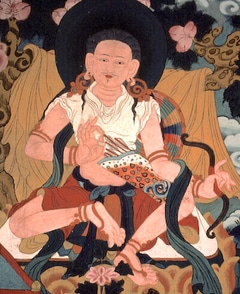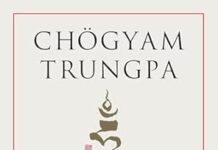
This is the story of Drukpa Kunley, a wandering, accomplished siddha and rascal who continually confounds the people and religious institutions of his time, who is assiduous in exposing the rampant hypocrisies he encounters, who both insults and awakens myriads, and who today is beloved as a major icon of enlightened crazy wisdom.
Drukpa Kunley’s antics and adventures are deeply instilled in the people, dharma and cultural legacy of Tibet and Bhutan. He lived in the fifteenth-century. The stories about him adorn the cultures of Himalayan Buddhism as one of the major gems of Buddhist lore and legend. Elizabeth Monson has mirrored that vitally living legacy of Drukpa Kunley in this provocative, adventuresome and eloquent account of Drukpa Kunley’s life.
Generally, Drukpa Kunley is popularized through the many accounts of his antics and magical feats. In this book, Monson adds the essential element of Drukpa Kunley’s life story, from his own accounts and those of subsequent lineage holders and biographical researchers. She folds in essential perspectives about Drukpa Kunley’s entire life, from a tragic childhood through rigorous spiritual training and retreat, through ceaseless wandering, through family life and travels with his son, through his many visions, through his flourishing activity as a wildly fresh and fully accomplished yogin, and through to his death.
At first I was irritated by the title of the book, Tales of a Mad Yogi. After reading Monson’s introduction, I was impressed with the sheer depth and dedication of her work over years in investigating and chronicling Drukpa Kunley’s life, stories, and songs. She displays the work and dedication of an excellent translator and research scholar. She assembles her knowledge not just from libraries and the internet, but by wandering in the same places Drukpa Kunley did, following his trail. Her translations are informed by her exhaustive interviews with lamas and lay people in Bhutan, Nepal, and elsewhere. She doesn’t just research Drukpa Kunley, but follows his scent, perhaps like Drukpa Kunley, who in one story follows a mysterious stag over hills and through forests to a valley of spiritual challenge and splendor. She combines her scholarly pursuit with the passion of the practitioner she is, sensing directly the enduring brilliance and potency of Drukpa Kunley’s legacy. She provides a summary of the “crazy yogi” phenomena and places it in the general context of Himalayan Buddhism. And she provides an overview of the four volumes of Drukpa Kunley’s collected works, The Liberation Tales, which she has translated as the foundation for this book. I thought, why call it just a collection of tales? It seems like so much more.
But then I launched into the stories. The title became delightfully appropriate. Rather than an informative yet regulated normal biography (which Monson was asked to do but turned down), Monson catches a wind of inspiration resonant with the spirit of Drukpa Kunley himself. Having trained and prepared, and researched and traveled and translated and consulted and recorded, her collective hard work and ensuing expertise serve as a strong shoulder from which she releases an arrow of literary eloquence and adventure. She dons the cloak of the storyteller, the bard, the singer of tales possessed by the enduring power of the tale itself. She lets her mind wander over the landscapes of Drukpa Kunley’s life, and catches the awakened whims of nowness where Drukpa Kunley always pitches his tent.
Yet amidst her eloquent renderings, she inserts the songs and stories from her translations and research, and makes the best use of them, placing them in the context of Drukpa Kunley’s life and encounters. In so doing, she retains their life force rather than condemning them to academic isolation or pious liturgical containment. She derives the most profound of Drukpa Kunley’s dharma instructions from the spontaneous contexts and encounters from which they spring.
Monson brings to light not just the fabulous exploits of a vajra trickster, but the solid ground from which his travels and encounters spring. As wildly spontaneous, magnetizing, confounding, and provoking as Drukpa Kunley is, his exploits grow from years of dedicated and assiduous spiritual training, retreat, and devotion to his root teachers. He traverses the three yanas as he travels the Tibetan plateau and Bhutan, serves his gurus, spends years in dedicated retreat, and avoids the trappings of distinction and recognition.
Yet when his character does blossom into the outrageous and magical displays of his exploits as a siddha, there is no pretense of just launching into uncontrived behavior, of exaggerating seminal dharma instructions into a self-indulgent mockery. Indeed, in Monson’s stories, Drukpa Kunley is highly critical of those casting themselves as crazy yogis with performances “meant to draw fame, attention and contributions.” Drukpa Kunley does the hard work, lives the tragedies and enduring sadnesses of the world, encounters the corruptions of religion and power, and never shrinks from pure unadulterated hardship.
Nor, for that matter, does Kunley shrink from the delights of spontaneous encounters and opportunities to cavort. He loves women and making love, loves to drink, loves to sing, loves to travel. He neither cloaks himself in religious virtuousness, nor contrived displays of outrageousness. His spirituality is the expression of sheer openness of mind and spirit.
That is where his training and his eventual utter authenticity as a siddha meet. Rather than discarding his own proclivities as a worldly person, he embraces them to the point where their underlying wisdom shines through. Despite the shock and initial disapproval in people encountering his brash, lusty, intoxicated displays, his wisdom captures the hearts of people who meet him, as they realize he is no ordinary fool, but a very enlightened fool. His famously lascivious and often inebriated interactions become his very skillful means in communicating directly with people and situations as an ordinary human being like them, or else in crude words and behavior that seem everything but spiritual. This ordinariness and worldliness are the portal by which Kunley then inspires and awakens them.
A case in point is the tale of an old man in Bhutan, Apa Tenzin, who pleads to Drukpa Kunley for a spiritual practice that will prepare him for death. Drukpa Kunley gives him a passage to memorize and recite every day. Gleeful for the gift, the old man starts to recite the passage loudly and continuously, but to the shock of his daughter and her family, the passage is full of crude references!
“You can’t be serious”, she exclaims, “are you crazy?” She forbids him from continuing the loud offensive verse. But he refuses to cease reciting, having deep faith in Drukpa Kunley, so the family exiles him to the hayloft in the roof of the house, where he continues his recitations uninterruptedly. The offensive words then are reduced to a distant melodic sound. But one day after a month, there is sudden silence, so the family goes to check on Apa Tenzin. Not finding any trace of him, they discover instead a sphere of rainbow light suspended above his bed! In one month of reciting the verse with complete devotion, he had attained the rainbow body of enlightenment.
Drukpa Kunley’s own early life of tragedies and encounters with religious and social hypocrisy and corruption lay the basis of his later searing indictments of the same whenever he encounters them. His father, a significant figure in the monastic life of Ralung, the seat of the Drukpa Kagyu lineage, is murdered by his brother in order to grab his land assets. Drukpa Kunley’s own mother, then, is forced to live in the household as a concubine to her husband’s murderer. Drukpa Kunley is raised in this utterly toxic environment. He leaves as soon as he is old enough, and pursues a spiritual life haunted by these early experiences.
Yet while being keenly sensitive to the hypocrisies of a culture defined by Buddhism, he is also aware of his own hypocrisies and pretenses. He is utterly honest with himself and with others. In this way, both his life and Monson’s renderings of it ring with authenticity.
Kunley is often engaged with taming troublesome local spirits and subduing unruly obstacles. While dealing with these external influences, he always relates such activities to Dharma practice. For instance, to a group of pilgrims in Bhutan terrified of a local demoness, Kunley discourses on Mara, or demons. After assuring the pilgrims “You will not be free from Mara until you have attained Buddhahood by means of realization of the ultimate nature”, he lists a series of more palpable Maras:
“A demon is of two kinds: subtle and gross. First, in regard to the subtle manifestations, anything that is not in accord with the dharma is Mara. If you take pleasure in mental elaboration while sitting in meditative equipoise, that is Mara. Similarly, if you think of something else at the same time that you make religious offerings or engage in practice, that is also Mara. If you turn your attention to another project without finishing the first, you won’t succeed in either one. The prevention of this success is also Mara.”
After further renditions of where more palpable demons are to be found, the pilgrims respond. “But”, the pilgrims looked at him with apprehension and sadness, “it seems like except for the Buddha, there is no-one who is not influenced by Mara.” “That’s true”, replies Kunley. “The point is that we must all face these kinds of obstructive energies, Rather than projecting your fears externally, the only way to subdue them is to look into your own mind.”
I happened to read Tales of a Mad Yogi while also rereading for the umpteenth time Chogyam Chogyam’s book Crazy Wisdom, in preparation for a Ri-mé Society class based on that book. The two books are wonderful dancing partners. What Trungpa Rinpoche lays bare as the inner core of Padmasambhava, and as the basic character of an uncontrived spiritual practice, Drukpa Kunley dances in the episodes of his life and encounters. Trungpa Rinpoche’s teachings in his Crazy Wisdom seminars are the book, Drukpa Kunley’s life in Tales of a Mad Yogi is the movie. As Drukpa Kunley is in the line of incarnations from which Trungpa Rinpoche sprang, it makes sense. From the bare necessity of hopelessness to sudden enlightenment, the discovery of awakened mind in each moment, major themes in Crazy Wisdom, Drukpa Kunley’s life follows suit. Like Drukpa Kunley’s life, Trungpa Rinpoche is sometimes scorned and criticized, and yet like Drukpa Kunley, Trungpa Rinpoche’s brilliance and fearlessness in presenting dharma can never be diminished or eclipsed. While reading Drukpa Kunley’s songs, I can hear Trungpa Rinpoche singing right along.
In one episode in Bhutan, Drukpa Kunley comes upon a large outdoor teaching gathering. Curious, Drukpa Kunley quickly learns that the teacher is Pema Lingpa, the renowned Nyingma terton (spiritual treasurer revealer). They engage in a wonderful antiphonal interchange, a crescendo of spontaneous genius, and following that there are no barriers distinguishing the realization of Pema Lingpa and Drukpa Kunley. They realize they are vajra brothers, and walk off hand-in-hand, delighting in their mutual dharma interchanges. Thus by chance encounter, the crazy wisdom of Ati joins hands with the crazy wisdom of Mahamudra.
Then there is the issue of magic. From the point of view of a more conventional accounting of buddhadharma, magic could be discounted as fantasy, myth, hyperbole, wishful thinking, or at best anecdote. Yet in the life of Drukpa Kunley, and for that matter the lives of all siddhas, magic cannot be denied or explained away as a literary device or as fantasy. The world of awakened mind is alive with magic, the magic which is beyond the barb-wire fences of conceptual mind and conventional reality. Magic is not anecdotal, it is the display of the unbounded awakened mind meeting the everyday world directly. Monson’s tales jump from Drukpa Kunley’s very grounded training to his blossoming as a siddha, and with that there are constant magical episodes. Too many to mention here, all the more enjoyable to read them in Monson’s tales. They are the spice in the banquet of Kunley’s enlightenment. They launch one’s mind into the world of the uncontrived.
The songs and episodes of Drukpa Kunley are an invitation to dance with his vast and mischievous mind. The net that Monson’s Tales of a Divine Madman weaves is a dancing floor for one to do just that.
***

ELIZABETH MONSON, PhD, is the spiritual codirector of Natural Dharma Fellowship and the managing teacher at Wonderwell Mountain Refuge. She is a Dharma teacher of Tibetan Buddhism, has lectured at the Harvard Divinity School, and teaches meditation throughout New England.


































